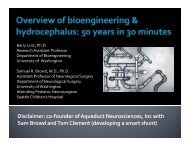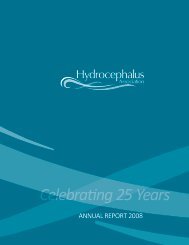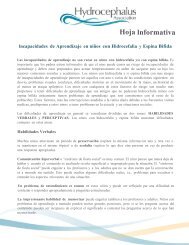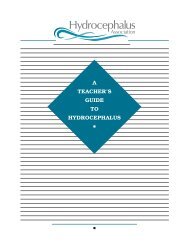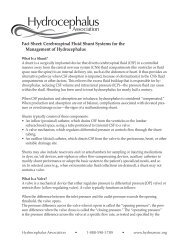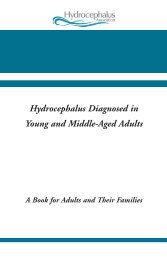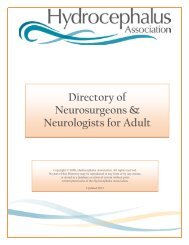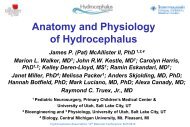Gait disorder in older adults: Is it NPH? - ResearchGate
Gait disorder in older adults: Is it NPH? - ResearchGate
Gait disorder in older adults: Is it NPH? - ResearchGate
Create successful ePaper yourself
Turn your PDF publications into a flip-book with our unique Google optimized e-Paper software.
<strong>Ga<strong>it</strong></strong> <strong>disorder</strong> <strong>in</strong> <strong>older</strong> <strong>adults</strong>: <strong>Is</strong> <strong>it</strong> <strong>NPH</strong>?<br />
States, or 5% of the population may have <strong>NPH</strong>. The numbers<br />
are expected to <strong>in</strong>crease due to extended longev<strong>it</strong>y. 3 In<br />
2005, an <strong>in</strong>ternational study group developed and reported<br />
comprehensive guidel<strong>in</strong>es for <strong>NPH</strong>. 3<br />
In <strong>NPH</strong>, there is an enlargement of the bra<strong>in</strong>’s ventricular<br />
system due to an excess of cerebrosp<strong>in</strong>al fluid (CSF) thought to<br />
be related to decreased reabsorption of CSF by the arachnoid<br />
villi surround<strong>in</strong>g the exterior of the bra<strong>in</strong> (see Normal flow of<br />
CSF). As the ventricles slowly enlarge from the accumulation<br />
of CSF, tissue compliance <strong>in</strong>creases and further ventricular<br />
enlargement results. 4 Subsequently, <strong>in</strong>creased <strong>in</strong>tracranial<br />
pressure is transient as the ventricles are able to accomodate<br />
more CSF. As the ventricles cont<strong>in</strong>ue to enlarge, edema, and<br />
permanent changes <strong>in</strong> the shape of the ventricles may cause<br />
periventricular and vascular damage. Add<strong>it</strong>ionally, compression<br />
of bra<strong>in</strong> parenchyma and vessels and the accumulation of<br />
tox<strong>in</strong>s due to slow refreshment of CSF and decreased clearance<br />
of metabol<strong>it</strong>es <strong>in</strong>creases CSF-flow obstruction and progressive<br />
ventriculomegaly. Signs and symptoms of <strong>NPH</strong> occur as<br />
various areas of the bra<strong>in</strong> are compressed. 4<br />
The etiology of <strong>NPH</strong> is unclear. Chrysikopoulos 4 states<br />
the perplex<strong>in</strong>g feature of <strong>NPH</strong> is the progressive enlargement<br />
of the ventricles <strong>in</strong> the absence of mechanical obstruction<br />
of CSF, along w<strong>it</strong>h a normal mean <strong>in</strong>traventricular and<br />
mean <strong>in</strong>tracranial pressure. <strong>NPH</strong> can be e<strong>it</strong>her idiopathic<br />
or secondary to head trauma, men<strong>in</strong>g<strong>it</strong>is, or subarachnoid<br />
bleed. The author hypothesized that <strong>in</strong> <strong>NPH</strong>, alterations<br />
<strong>in</strong> the normal systolic-diastolic cycle of blood flow <strong>in</strong> the<br />
bra<strong>in</strong> will disrupt the normal propulsion of CSF. Abnormal<br />
ventricular systole <strong>in</strong> the bra<strong>in</strong> is thought to be caused by<br />
stiff and narrowed arteries due to atherosclerosis and hypertension.<br />
4 Poor circulation of CSF is proposed to result <strong>in</strong><br />
toxic/osmotic effects that may <strong>in</strong>clude cellular and axonal<br />
dehydration. Chrysikopoulos 4 states there is evidence l<strong>in</strong>k<strong>in</strong>g<br />
<strong>NPH</strong> to diseases of the cerebral arteries.<br />
Krauss et al 5 <strong>in</strong>vestigated vascular risk factors and arteriosclerotic<br />
disease <strong>in</strong> <strong>NPH</strong> <strong>in</strong> <strong>older</strong> <strong>adults</strong>. The sample<br />
<strong>in</strong>cluded 65 participants who ranged <strong>in</strong> age from 50 to 87<br />
w<strong>it</strong>h a mean age of 70.8 years. Forty-six percent were men,<br />
and 54% were women. Variables exam<strong>in</strong>ed <strong>in</strong>cluded systemic<br />
arterial hypertension, diabetes mell<strong>it</strong>us, smok<strong>in</strong>g, hyperlipidemia,<br />
hypercholesterolemia, obes<strong>it</strong>y, and cardiac, cerebrovascular,<br />
and other arteriosclerotic disease. A highly significant<br />
association was found between <strong>NPH</strong> and systemic arterial<br />
hypertension. A pos<strong>it</strong>ive relationship was also found between<br />
the sever<strong>it</strong>y of cl<strong>in</strong>ical symptoms of <strong>NPH</strong> and the presence<br />
of systemic arterial hypertension, especially for severe ga<strong>it</strong><br />
disturbance. Diabetes mell<strong>it</strong>us was found to be associated<br />
w<strong>it</strong>h <strong>NPH</strong>; however, when the variables were exam<strong>in</strong>ed us<strong>in</strong>g<br />
logistic regression, only systemic arterial hypertension was<br />
found to have a significant association w<strong>it</strong>h <strong>NPH</strong>.<br />
S<strong>in</strong>ce <strong>NPH</strong> typically is most common <strong>in</strong> <strong>in</strong>dividuals <strong>in</strong><br />
their sixth and seventh decades, <strong>it</strong>s characteristic triad of<br />
symptoms can be easily mistaken for other cond<strong>it</strong>ions attributed<br />
to ag<strong>in</strong>g, thereby delay<strong>in</strong>g <strong>it</strong>s diagnosis. 6 The diagnosis<br />
of <strong>NPH</strong> does not require the presence of all three symptoms.<br />
The first symptom to be exhib<strong>it</strong>ed is usually a change <strong>in</strong> ga<strong>it</strong>,<br />
while cogn<strong>it</strong>ive and ur<strong>in</strong>ary changes occur later. In fact, if<br />
cogn<strong>it</strong>ive impairment occurs before disturbances <strong>in</strong> ga<strong>it</strong> then<br />
<strong>NPH</strong> is probably not present. 7,8<br />
■ Dist<strong>in</strong>ctive ga<strong>it</strong> of <strong>NPH</strong><br />
<strong>NPH</strong> is a diagnostic challenge w<strong>it</strong>h ga<strong>it</strong> impairment as the<br />
card<strong>in</strong>al sign. 9 <strong>Ga<strong>it</strong></strong> disturbance is an early sign of <strong>NPH</strong>.<br />
The dist<strong>in</strong>ctive ga<strong>it</strong> is described as hav<strong>in</strong>g reduced veloc<strong>it</strong>y,<br />
dim<strong>in</strong>ished stride length, broad-based, and reduced<br />
foot-to-floor clearance. There is an <strong>in</strong>creased foot angle,<br />
w<strong>it</strong>h the feet rotated outward. 10 Step height is greatly<br />
dim<strong>in</strong>ished, giv<strong>in</strong>g the appearance that the person’s feet<br />
are stuck to the floor. 1<br />
Older <strong>adults</strong> w<strong>it</strong>h <strong>NPH</strong> tend to hes<strong>it</strong>ate when <strong>in</strong><strong>it</strong>iat<strong>in</strong>g<br />
ambulation or turn<strong>in</strong>g. They are unsteady and lose their<br />
balance easily. <strong>NPH</strong> is dist<strong>in</strong>guished from a similar ga<strong>it</strong> <strong>in</strong><br />
Park<strong>in</strong>son disease by the preservation of reciprocal arm<br />
sw<strong>in</strong>g when walk<strong>in</strong>g. 11 Also, a levodopa challenge may be<br />
done to differentiate between <strong>NPH</strong> and Park<strong>in</strong>son disease.<br />
Patients w<strong>it</strong>h <strong>NPH</strong> will not respond to levadopa. 12<br />
Those w<strong>it</strong>h <strong>NPH</strong> struggle to rise from a seated pos<strong>it</strong>ion<br />
and have difficulty <strong>in</strong><strong>it</strong>iat<strong>in</strong>g the first steps <strong>in</strong> walk<strong>in</strong>g. Climb<strong>in</strong>g<br />
stairs may be problematic, as their step height is dim<strong>in</strong>ished<br />
and their stride length is shortened. Some patients may<br />
only present w<strong>it</strong>h a history of frequent falls. 7,13 Individuals<br />
w<strong>it</strong>h <strong>NPH</strong> may also appear to lean backwards slightly when<br />
stand<strong>in</strong>g and ambulat<strong>in</strong>g and have a larger sway area than<br />
healthy <strong>in</strong>dividuals. 14<br />
■ Cogn<strong>it</strong>ive impairment<br />
Cogn<strong>it</strong>ive impairments <strong>in</strong> <strong>NPH</strong> can range from m<strong>in</strong>imally<br />
detected to profoundly severe. Over time, cogn<strong>it</strong>ive impairments<br />
may become more generalized and more difficult to<br />
manage. 2 In <strong>NPH</strong>, cogn<strong>it</strong>ive impairment typically <strong>in</strong>cludes<br />
<strong>in</strong>attentiveness, lack of spontane<strong>it</strong>y, and latency <strong>in</strong> recall. The<br />
process<strong>in</strong>g of <strong>in</strong>formation tends to be slow. A fact recalled<br />
by a person w<strong>it</strong>h <strong>NPH</strong> is most often accurate. The answers<br />
provided to questions are frequently correct. The dementia<br />
from <strong>NPH</strong> is dist<strong>in</strong>ct from that noted <strong>in</strong> a person w<strong>it</strong>h Alzheimer<br />
disease (AD). The <strong>in</strong>dividual w<strong>it</strong>h <strong>NPH</strong> should not<br />
have difficulty w<strong>it</strong>h word formation or carry<strong>in</strong>g out simple<br />
tasks that do not require concentration. 13<br />
Differentiat<strong>in</strong>g between cortical and subcortical defic<strong>it</strong>s<br />
is key to dist<strong>in</strong>guish<strong>in</strong>g <strong>NPH</strong> from other cogn<strong>it</strong>ive<br />
impairments and dementias. If cogn<strong>it</strong>ive impairment is<br />
www.tnpj.com The Nurse Pract<strong>it</strong>ioner • March 2011 15<br />
Copyright © 2011 Lipp<strong>in</strong>cott Williams & Wilk<strong>in</strong>s. Unauthorized reproduction of this article is prohib<strong>it</strong>ed.



